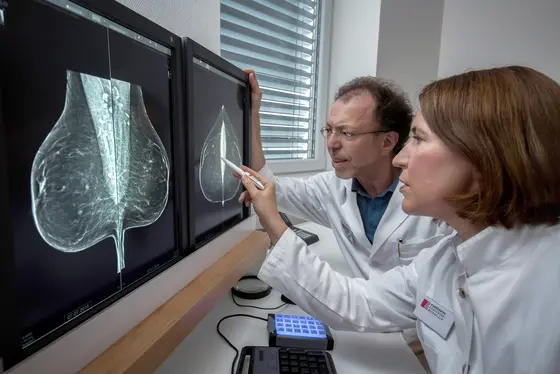Experts currently estimate that one or two in 1,000 women who have undergone regular mammography screening exams over the past ten years are saved from dying from breast cancer because their cancer has been found at a stage when it can still be cured. This is a potential benefit of mammography screening. But critics argue that there are also possible drawbacks, namely radiation exposure, unnecessary worries in the case of falsely positive findings and overdiagnosis, i.e., the detection of slowly growing tumors that would never have caused problems during a woman's lifetime.
“This situation could be improved by personalized early detection screening that would be adjusted to the individual breast cancer risk,“ said Rudolf Kaaks from the German Cancer Research Center (Deutsches Krebsforschungszentrum, DKFZ). Kaaks explained: “On one side, there is the benefit of mammography, namely a reduced mortality rate from breast cancer. On the other side, there are risks such as overdiagnosis, falsely positive results, and ultimately also the costs. Our goal is to shift this balance towards the benefits.“
Women with an increased breast cancer risk, i.e., with an increased likelihood of actually being affected by a tumor, naturally benefit most from screening exams. “To these women we could offer mammography examinations at short intervals, and they might also have to start undergoing screening exams already at age 45. For women with a lower risk it would be sufficient to undergo mammography screenings at longer intervals.“
But how can one determine a woman's individual risk of getting breast cancer? Scientists have developed mathematical models for predicting this risk. These models are based primarily on data from a woman's reproductive history: At what age did she have her first menstrual period? When did she first give birth, how many children did she have altogether? When did menopause start? Did the woman use hormonal contraceptives or take hormonal replacement therapy drugs? The body mass index (BMI) is another factor included in the commonly used risk assessment models as well as the number of cancer cases among direct relatives.
Annika Hüsing from Kaak's department was recently showed that the models become even more accurate when hormone levels are also integrated; at least this is the case for postmenopausal women. In her study, the scientist used blood samples from participants in the European Prospective Investigation into Cancer and Nutrition (EPIC) study, a large-scale European study on nutrition, lifestyle and cancer. The levels of sex hormones estradiol and testosterone found in the samples were added to the model and substantially improved its predictiveness. This work by the DKFZ epidemiologists has confirmed results of a study from Harvard for the first time.
The risk prediction models are not conceived for women with a known mutation of the famous breast cancer genes BRCA1 and BRCA2 and who therefore have an exceptionally high risk of developing breast cancer. However, besides the BRCA mutations, every individual has a multitude of very small gene variants in their genomes, each of which, taken on its own, has only minimal impact. Taken together, however, they can significantly increase the breast cancer risk. Scientists are currently investigating the magnitude of this impact in large international specialist networks in which the DKFZ epidemiologists from Kaak's department are also involved. These genetic risk profiles will also be integrated into the models as additional biological markers.
It is also important to adjust the calculations to the respective population. Hüsing is currently adapting the most commonly used mathematical models, which are based on data from the U.S.A., to conditions in Germany. “In this country, women are older when they first give birth and they also have fewer children than women in the U.S. In addition, the practice of prescribing hormonal therapies differs.“
“Now the challenge is to join all these calculations together,“ said DKFZ epidemiologist Kaaks, and he added: “Screening exams for early cancer detection affect millions of people. Therefore, we must continuously examine whether and how they can be further improved.“
Please find more information on mammography screening from the Cancer Information Service (KID) of the German Cancer Research Center at
www.krebsinformationsdienst.de/vorbeugung/frueherkennung/mammographie-frueherkennung.php
Hüsing A, Fortner RT, Kühn T, Overvad K, Tjønneland A, Olsen A, Boutron-Ruault MC, Severi G, Fournier A, Boeing H, Trichopoulou A, Benetou V, Orfanos P, Masala G, Pala V, Tumino R, Fasanelli F, Panico S, Bueno de Mesquita HB, Peeters PH, van Gills CH, Quirós JR, Agudo A, Sánchez MJ, Chirlaque MD, Barricarte A, Amiano P, Khaw KT, Travis RC, Dossus L, Li K, Ferrari P, Merritt MA, Tzoulaki I, Riboli E, Kaaks R. Added Value of Serum Hormone Measurements in Risk Prediction Models for Breast Cancer for Women Not Using Exogenous Hormones: Results from the EPIC Cohort. Clin Cancer Res. 2017 DOI:10.1158/1078-0432.CCR-16-3011
Paige Maas, Myrto Barrdahl et al: Breast Cancer Risk From Modifiable and Nonmodifiable Risk Factors Among White Women in the United States. JAMA Oncology 2016, DOI 10.1001/jamaoncol.2016.1025
